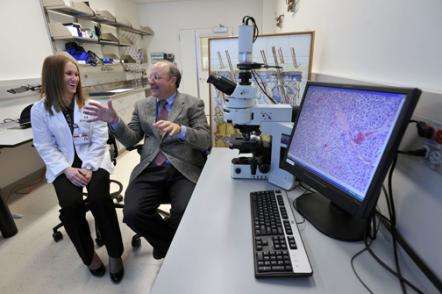Tide is turning in skin cancer battle

A decade ago there was little doctors could do to help a patient with advanced-stage melanoma. Now it seems each week yields important new discoveries about the deadly skin cancer.
"I've been doing this for 30 years, and now is by any measure the most exciting time for melanoma research," said Brian Nickoloff, director of the Nicholas V. Perricone, M.D., Division of Dermatology and Cutaneous Sciences at Michigan State University's College of Human Medicine.
In the research journal Laboratory Investigation, Nickoloff and colleagues outline recent advances that have put melanoma at the forefront of cancer research, raising hopes that scientists and clinicians may have cornered the deadliest of all skin cancers.
"In the past melanoma outsmarted us, but now we're starting to outsmart melanoma," said Nickoloff, who also is director of cutaneous oncology at Van Andel Research Institute in Grand Rapids and a member of the Stand Up to Cancer Dream Team for melanoma research. "Go back 10 years and you'll see we had almost nothing to offer patients with advanced disease, but now we're definitely getting the upper hand on this cancer."
Melanoma is really a catch-all term for the most virulent types of skin cancer. The disease's complexity is staggering—melanoma tumors have more mutations per cell than any other type of cancer—but new diagnostic tools such as DNA sequencing are helping scientists sort through troves of data to decode each tumor's "fingerprint."
And while the list of known mutations that cause melanoma keeps growing, researchers can target most of them by blocking a handful of the "signaling pathways" that control normal cell function and can cause tumors to form and spread.
Meanwhile, about 100 new drugs with melanoma in their sights are in development, and new combinations of drugs show promise for blocking cancer-causing signaling pathways.
Still, optimism about such progress is tempered by the fact that someone dies from melanoma every hour. Besides being deadly, melanoma is one of the fastest growing cancers worldwide. Melanoma also is unusual among cancers in how often it develops in young people; it is one of the leading causes of cancer-related deaths in 25- to 29-year-old women.
Science's rapid progress in understanding and treating melanoma must be coupled with prevention efforts to educate people about the dangers of sun exposure and artificial tanning, Nickoloff said.
"It's entirely preventable," he said. "Nobody should die from advanced-stage melanoma."
Education was part of the goal of the College of Human Medicine's Gran Fondo, a June bicycling event in Grand Rapids that in its first year attracted 1,500 cyclists and raised about $100,000 for MSU melanoma research.
Nickoloff said that community support is matched by an increasingly collaborative research atmosphere in Grand Rapids—his co-authors on the new paper included Michigan State medical students and cancer experts from Van Andel and Mercy Health Saint Mary's—that will keep MSU and its West Michigan partners at the leading edge of melanoma research.
"I wish I were 20 years younger, because we're going to see more and more long-term remissions," he said. "We'll get better every year we're at this."

















